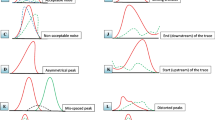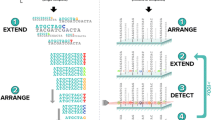Abstract
Massively parallel sequencing (MPS) technologies enable the simultaneous analysis of short tandem repeats (STRs) and single nucleotide polymorphisms (SNPs). MPS also enables the detection of alleles of the minor contributors in imbalanced DNA mixtures. In this study, 59 STRs (amelogenin, 27 autosomal STRs, 7 X-STRs, and 24 Y-STRs) and 94 identity-informative SNPs of 119 unrelated Taiwanese (50 men, 69 women) were sequenced using a commercial MPS kit. Forty-eight nondegraded and 44 highly degraded two-person artificial DNA mixtures with various minor to major ratios (1:9, 1:19, 1:29, 1:39, 1:79, and 1:99) were analyzed to examine the performance of this system for detecting the alleles of the minor contributors in DNA mixtures. Likelihood ratios based on continuous model were calculated using the EuroForMix for DNA mixture interpretation. The STR and SNP genotypes of these 119 Taiwanese were obtained. Several sequence variants of STRs were observed. Using EuroForMix software based on the sequence data of autosomal STRs and autosomal SNPs, 97.9% (47/48) and 97.7% (42/43) of minor donors were accurately inferred among the successfully analyzed nondegraded and degraded DNA mixtures, respectively. In conclusion, combined with EuroForMix software, this commercial kit is effective for assignment of the minor contributors in nondegraded and degraded DNA mixtures.

Similar content being viewed by others
References
Dixon LA, Murray CM, Archer EJ, Dobbins AE, Koumi P, Gill P (2005) Validation of a 21-locus autosomal SNP multiplex for forensic identification purposes. Forensic Sci Int 154:62–77
Hwa HL, Chang YY, Lee JC, Lin CY, Yin HY, Tseng LH, Su YN, Ko TM (2012) Fifteen non-CODIS autosomal short tandem repeat loci multiplex data from nine population groups living in Taiwan. Int J Legal Med 126:671–675
Hwa HL, Wu LS, Lin CY, Huang TY, Yin HI, Tseng LH, Lee JC (2016) Genotyping of 75 SNPs using arrays for individual identification in five population groups. Int J Legal Med 130:81–89
Pakstis AJ, Speed WC, Fang R, Hyland FC, Furtado MR, Kidd JR, Kidd KK (2010) SNPs for a universal individual identification panel. Hum Genet 127:315–324
Pakstis AJ, Haigh E, Cherni L, ElGaaied ABA, Barton A, Evsanaa B, Togtokh A, Brissenden J, Roscoe J, Bulbul O, Filoglu G, Gurkan C, Meiklejohn KA, Robertson JM, Li CX, Wei YL, Li H, Soundararajan U, Rajeevan H, Kidd JR, Kidd KK (2015) 52 additional reference population samples for the 55 AISNP panel. Forensic Sci Int Genet 19:269–271
Walsh S, Chaitanya L, Clarisse L, Wirken L, Draus-Barini J, Kovatsi L, Maeda H, Ishikawa T, Sijen T, de Knijff P, Branicki W, Liu F, Kayser M (2014) Developmental validation of the HIrisPlex system: DNA-based eye and hair colour prediction for forensic and anthropological usage. Forensic Sci Int Genet 9:150–161
Churchill JD, Schmedes SE, King JL, Budowle B (2016) Evaluation of the Illumina(®) beta version ForenSeq™ DNA signature prep kit for use in genetic profiling. Forensic Sci Int Genet 20:20–29
Silvia AL, Shugarts N, Smith J (2017) A preliminary assessment of the ForenSeq™ FGx system: next generation sequencing of an STR and SNP multiplex. Int J Legal Med 131:73–86
Rockenbauer E, Hansen S, Mikkelsen M, Børsting C, Morling N (2014) Characterization of mutations and sequence variants in the D21S11 locus by next generation sequencing. Forensic Sci Int Genet 8:68–72
Van Neste C, Vandewoestyne M, Van Criekinge W, Deforce D, Van Nieuwerburgh F (2014) My-forensic-loci-queries (MyFLq) framework for analysis of forensic STR data generated by massive parallel sequencing. Forensic Sci Int Genet 9:1–8
Børsting C, Morling N (2015) Next generation sequencing and its applications in forensic genetics. Forensic Sci Int Genet 18:78–89
Kim EH, Lee HY, Yang IS, Jung SE, Yang WI, Shin KJ (2016) Massively parallel sequencing of 17 commonly used forensic autosomal STRs and amelogenin with small amplicons. Forensic Sci Int Genet 22:1–7
Van Neste C, Van Nieuwerburgh F, Van Hoofstat D, Deforce D (2012) Forensic STR analysis using massive parallel sequencing. Forensic Sci Int Genet 6:810–818
Warshauer DH, Davis CP, Holt C, Han Y, Walichiewicz P, Richardson T, Stephens K, Jager A, King J, Budowle B (2015) Massively parallel sequencing of forensically relevant single nucleotide polymorphisms using TruSeq™ forensic amplicon. Int J Legal Med 129:31–36
van der Gaag KJ, de Leeuw RH, Hoogenboom J, Patel J, Storts DR, Laros JFJ, de Knijff P (2016) Massively parallel sequencing of short tandem repeats-population data and mixture analysis results for the PowerSeq™ system. Forensic Sci Int Genet 24:86–96
Hussing C, Børsting C, Mogensen HS, Morling N (2015) Testing of the Illumina® ForenSeq™ kit. Forensic Sci Int genet Suppl. Ser 5:e449–e450
Xavier C, Parson W (2017) Evaluation of the Illumina ForenSeq™ DNA signature prep kit - MPS forensic application for the MiSeq FGx™ benchtop sequencer. Forensic Sci Int Genet 28:188–194
Jäger AC, Alvarez ML, Davis CP, Guzmán E, Han Y, Way L, Walichiewicz P, Silva D, Pham N, Caves G, Bruand J, Schlesinger F, Pond SJ, Varlaro J, Stephens KM, Holt CL (2017) Developmental validation of the MiSeq FGx forensic genomics system for targeted next generation sequencing in forensic DNA casework and database laboratories. Forensic Sci Int Genet 28:52–70
Bleka Ø, Storvik G, Gill P (2016) EuroForMix: an open source software based on a continuous model to evaluate STR DNA profiles from a mixture of contributors with artefacts. Forensic Sci Int Genet 21:35–44
Bleka Ø, Eduardoff M, Santos C, Phillips C, Parson W, Gill P (2017) Open source software EuroForMix can be used to analyze complex SNP mixtures. Forensic Sci Int Genet 31:105–110
Just RS, Irwin JA (2018) Use of the LUS in sequence allele designations to facilitate probabilistic genotyping of NGS-based STR typing results. Forensic Sci Int Genet 34:197–205
Hwa HL, Chung WC, Chen PL, Lin CP, Li HY, Yin HI, Lee JC (2018) A 1204-single nucleotide polymorphism and insertion-deletion polymorphism panel for massively parallel sequencing analysis of DNA mixtures. Forensic Sci Int Genet 32:94–101
Illumina, Inc. (2015) Illumina ForenSeq™ DNA Signature Prep Guide (Part # 15049528 Rev. D), http://support.illumina.com/content/dam/illumina-support/documents/documentation/chemistry_documentation/forenseq/forenseq-dna-signature-prep-guide-15049528-d.pdf. accessed 13 November 2017
Illumina, Inc. (2016) ForenSeq™ Universal Analysis Software Guide (15053876 v01), https://support.illumina.com/content/dam/illumina-support/documents/documentation/software_documentation/forenseq-universal-analysis-software/forenseq-universal-analysis-software-guide-15053876-01.pdf. accessed 13 November 2017
Wendt FR, King JL, Novroski NM, Churchill JD, Ng J, Oldt RF, McCulloh KL, Weise JA, Smith DG, Kanthaswamy S, Budowle B (2017) Flanking region variation of ForenSeq™ DNA signature prep kit STR and SNP loci in Yavapai native Americans. Forensic Sci Int Genet 28:146–154
Fattorini P, Previderé C, Carboni I, Marrubini G, Sorçaburu-Cigliero S, Grignani P, Bertoglio B, Vatta P, Ricci U (2017) Performance of the ForenSeq™ DNA signature prep kit on highly degraded samples. Electrophoresis 38:1163–1174
Guo F, Yu J, Zhang L, Li J (2017) Massively parallel sequencing of forensic STRs and SNPs using the Illumina® ForenSeq™ DNA signature prep kit on the MiSeq FGx™ forensic genomics system. Forensic Sci Int Genet 31:135–148
Gettings KB, Kiesler KM, Vallone PM (2015) Performance of a next generation sequencing SNP assay on degraded DNA. Forensic Sci Int Genet 19:1–9
Guo SW, Tompson EA (1992) Performing the exact test of Hardy–Weinberg proportion for multiple alleles. Biometrics 48:361–372
Slatkin M (1994) Linkage disequilibrium in growing and stable populations. Genetics 137:331–336
Zaiontz C (2017) Cronbach’s Alpha. http://www.real-statistics.com/reliability/cronbachs-alpha/. accessed 13 November 2017
Buckleton J, Curran J (2008) A discussion of the merits of random man not excluded and likelihood ratios. Forensic Sci Int Genet 2:343–348
Butler JM (2015) Introduction and issue summary: new trends in forensic genetics. Forensic Sci Int Genet 18:1–3
Grandell I, Samara R, Tillmar AO (2016) A SNP panel for identity and kinship testing using massive parallel sequencing. Int J Legal Med 130:905–914
Bland JM, Altman DG (1995) Multiple significance tests: the Bonferroni methods. BMJ 310:170
Hill CR, Kline MC, Coble MD, Butler JM (2008) Characterization of 26 miniSTR loci for improved analysis of degraded DNA samples. J Forensic Sci 53:73–80
Aponte RA, Gettings KB, Duewer DL, Coble MD, Vallone PM (2015) Sequence-based analysis of stutter at STR loci: characterization and utility. Forensic Sci Int Genet Suppl Ser 5:e456–e458
Bieber FR, Buckleton JS, Budowle B, Butler JM, Coble MD (2016) Evaluation of forensic DNA mixture evidence: protocol for evaluation, interpretation, and statistical calculations using the combined probability of inclusion. BMC Genet 17:125
Just RS, Moreno LI, Smerick JB, Irwin JA (2017) Performance and concordance of the ForenSeq™ system for autosomal and Y chromosome short tandem repeat sequencing of reference-type specimens. Forensic Sci Int Genet 28:1–9
Zeng X, King JL, Stoljarova M, Warshauer DH, LaRue BL, Sajantila A, Patel J, Storts DR, Budowle B (2015) High sensitivity multiplex short tandem repeat loci analyses with massively parallel sequencing. Forensic Sci Int Genet 16:38–47
Seo SB, King JL, Warshauer DH, Davis CP, Ge J, Budowle B (2013) Single nucleotide polymorphism typing with massively parallel sequencing for human identification. Int J Legal Med 127:1079–1086
Acknowledgements
The authors thank the National Center for Genome Medicine at Academia Sinica, Taiwan, for performance of genome-wide analysis with Genome-Wide Human SNP Array 6.0. This Center was supported by grants from the National Core Facility Program for Biotechnology of National Science Council, Taiwan, R.O.C. We acknowledge Mr. Chun-Yen Lin and Ms. Tsun-Ying Huang for technical support on degraded DNA analysis. We thank Jia-Ching Hwa for manuscript typing and partial data calculation. Special thanks are given to the hundreds of individuals who volunteered to provide biological samples for allele frequency data studies.
Funding
This work was supported by the Ministry of Science and Technology, Taiwan, R.O.C. [grant numbers MOST 103-2320-B-002-023-MY2], and National Taiwan University Hospital Taiwan, R.O.C. [grant numbers NTUH103-S2398].
Author information
Authors and Affiliations
Corresponding author
Ethics declarations
Ethical approval
All procedures performed in studies involving human participants were in accordance with the ethical standards of the institutional and/or national research committee and with the 1964 Helsinki declaration and its later amendments or comparable ethical standards.
Informed consent
Informed consent was obtained from all individual participants included in the study.
Conflict of interest
The authors declare that they have no conflict of interest.
Electronic supplementary material
Supplementary Figure S1
(PDF 59 kb)
Supplementary Figure S2
(PDF 29 kb)
Supplementary Figure S3
(PDF 268 kb)
Supplementary Figure S4
(PDF 59 kb)
Supplementary Figure S5
(PDF 34 kb)
Supplementary Table S1
(PDF 21 kb)
Supplementary Table S2
(PDF 62 kb)
Supplementary Table S3
(PDF 38 kb)
Supplementary Table S4
(PDF 5 kb)
Supplementary Table S5
(PDF 128 kb)
Supplementary Table S6
(PDF 115 kb)
Rights and permissions
About this article
Cite this article
Hwa, HL., Wu, MY., Chung, WC. et al. Massively parallel sequencing analysis of nondegraded and degraded DNA mixtures using the ForenSeq™ system in combination with EuroForMix software. Int J Legal Med 133, 25–37 (2019). https://doi.org/10.1007/s00414-018-1961-y
Received:
Accepted:
Published:
Issue Date:
DOI: https://doi.org/10.1007/s00414-018-1961-y




